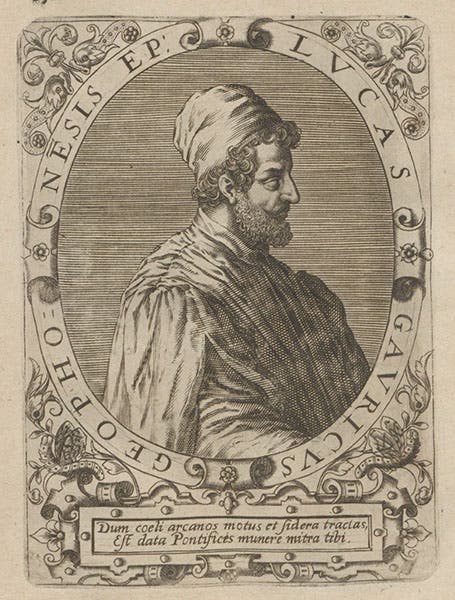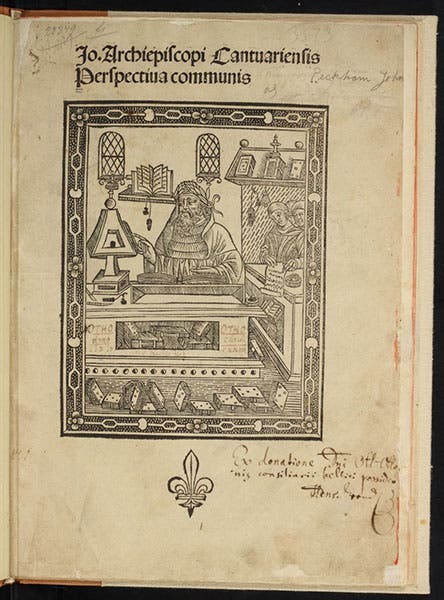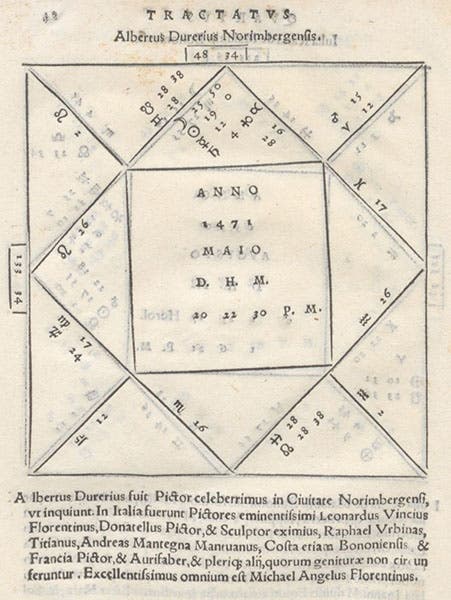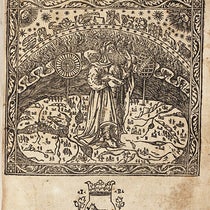Scientist of the Day - Luca Gaurico
Luca Gaurico, an Italian astrologer, was born Mar. 12, 1475. Astrology was a very competitive profession in Renaissance Italy, as princes and popes wanted to know the most propitious times to get married, have children, launch battles, or build churches and castles, and advice was right there in the stars, if one could read the signs properly. The key to a proper prognostication was the geniture, or horoscope for the time of birth or onset of action, where the astrologer recorded the positions of the planets and influential stars within the signs of the Zodiac at that specific time, and the location of the "head and trail of the dragon," where the orbit of the moon crossed the ecliptic. All astrologers used the same kind of 12-sided diagram, where the 12 signs of the zodiac were represented around the outside, and the 12 triangles represented the 12 "houses", starting at the nine-o’clock position and running counterclockwise. Each house had a special astrological meaning. The exact position of each planet at the time of birth, given in degrees and minutes, was written within the proper house.
Gaurico was especially well regarded as an astrologer and worked for prominent figures, such as Pope Paul III. He is said to have predicted the early deaths of several notable men. In a series of anonymous pamphlets and ephemera, he predicted a worldwide flood for 1524, when many of the planets would be in conjunction in the watery sign of Pisces. When the flood did not appear as predicted, he moved on, like any good astrologer.
Astrology was usually a private affair between the astrologer and his patron or customer, but in the 1540s, a Milanese astrologer, Girolamo Cardano, issued two volumes, the second an expansion of the first, it which he provided genitures for all to see of 100 famous people, popes and princes, as well as religious reformers and natural philosophers, and the occasional artist. We have published posts on both of these books; the Five Books of 1547, which we wrote first, and then its predecessor, the Two Books of 1543, which was published more recently.
Cardano had no use for Gaurico. Cardano's father Fazio had published the first edition of John Peckham’s medieval treatise on perspective in 1482; Gaurico later published his own edition (1504), which we happen to own in a slighter later edition (1510, third image), in which he savagely attacked the work of the elder Cardano. Cardano did not much like his father, but family was family. Nor did Cardano care for Gaurico’s reliance on ancient astrologers such as Firmicus Maternus and Manilius, whom Cardano found lacking in astronomical knowledge, since they often put planets in impossible positions in their horoscopes. So in both his Two Books and his Five Books, Cardano did not hesitate to point out where Gaurico had predicted an early death that did not materialize, or, in his opinion, had misread a geniture. He even maintained that Gaurico was off by an entire year in his birth date for Martin Luther, which Gaurico had assigned to 1484, in order to take advantage of a great conjunction that occurred that year, predicting Luther’s rebellious nature. Cardano put it in 1483, long before the conjunction took place. In Gaurico’s partial defense, Luther himself did not know what year he was born (although Luther’s brother insisted on 1483).
Cardano kicked the wrong dog. Gaurico published his Tratatus astrologicus in 1552, and we happen to have this work in our collections (fourth image), as well as Cardano’s two earlier compendia. It is similar to Cardano’s two works, but thicker, not because it has more genitures, but because the discussion of each is longer and more thorough. We show four genitures from Gaurico’s Tractatus in this post, those of Luther (first image); Johannes Regiomontanus, a Renaissance astronomer (fifth image); Cornelius Agrippa, natural magician (sixth image); and Albrecht Dürer, artist, print-master, and star-mapper (seventh image).
In his Tractatus, Gaurico gave as good as he got from Cardano, and because he wrote in 1552, he had the last word. He pointed out every error that he could find in Cardano’s genitures, and described every instance where a Cardano prognostication went awry. Cardano, for example, predicted a long life for King Henry VIII of England, who died in 1547, the year Cardano’s book came out. Gaurico showed that, with a proper interpretation of Henry’s geniture, an early death was easily foreseen. He defended his assignment of Luther’s birth year to 1484, because the five-fold planetary conjunction in the ninth house, the house of religion, explained perfectly both Luther’s heresy and his tendency to madness. In Gaurico’s geniture of Luther (first image), note the positioning of five planets, including the “great ones,” Jupiter and Saturn, in the ninth house (one o’clock position).
Subsequent astrologers always had the works of Cardano and Gaurico side by side on their desks, choosing between them in their own prognostications. The two may have despised each other, but they were both widely respected by their contemporaries and successors, despite their differences. And because Cardano was an outlier, and difficult to get along with, while Gaurico was a political insider, a member of a papal court, I suspect that, when interpretations differed, Gaurico’s prognostications usually got the nod.
Our copy of Gaurico’s Tractatus was acquired just last fall by Rare Book Librarian Jason Dean at the Boston Book Fair, where it was being offered by Sokol Books. Like many books of genitures, it has been extensively annotated by two 17th-century users who have been identified. See our catalog record for details.
And as usual, for any post discussing Renaissance astrology, and especially one on Cardano and Gaurico, I am indebted to Anthony Grafton’s masterful book, Cardano’s Cosmos: The Worlds and Works of a Renaissance Astrologer (1999).
William B. Ashworth, Jr., Consultant for the History of Science, Linda Hall Library and Associate Professor emeritus, Department of History, University of Missouri-Kansas City. Comments or corrections are welcome; please direct to ashworthw@umkc.edu.











![Using an astrolabe to measure the depth of a well, woodcut in Elucidatio fabricae vsusq[ue] astrolabii, by Johannes Stöffler, 1513 (Linda Hall Library)](https://assets-us-01.kc-usercontent.com:443/9dd25524-761a-000d-d79f-86a5086d4774/a998eb50-55d2-4a88-ace2-a50aa5fa86e7/Stoffler%201.jpg?w=210&h=210&auto=format&fit=crop)

